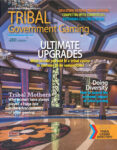
Locking Up Land
Will Interior limit land-into-trust? By Judith Shapiro
Establishing a tribal land base is painfully difficult. Nearly 140 years after the General Allotment Act systematically dismantled tribal land holdings, more than 80 years after the Indian Reorganization Act aimed to revitalize tribal lands, and only nine years after the Carcieri decision slammed the brakes on many tribes’ applications, the intentions of the current administration are not yet clear.
Under President Barack Obama, the United States acquired more than a half million acres in trust for tribes. In its first year, the Trump administration’s Interior Department, under Ryan Zinke, has accepted title to a tiny fraction of that total, and there is concern that the future may look more like the George W. Bush unofficial moratorium.
“Off-reservation gaming” is the hot-button label employed by those who would prefer that tribal economic activity stay on the reservation. That attack is used broadly, even as to tribes that have no reservation to be “off” of. Tribes that clearly warrant the remedial Indian land provisions spelled out in in the Indian Gaming Regulatory Act (newly recognized, restored after termination, lands acquired in settlement of a land claim) are accused of “reservation shopping,” as if they had historically chosen alienation from their traditional homelands. Tribes seeking new gaming lands seldom find an easy path.
IGRA and Interior Department regulations already limit the use of new trust land for gaming. Very few such applications succeed, and the new administration seems unlikely to enhance opportunities.
From the outset, the new administration has shown its intent to control the land-in-trust process more closely. Last April, the Interior Department called for all off-reservation land applications to be reviewed, and decided in the Central Office, rather than in the Regional Offices. Off-reservation gaming applications were made subject to the control of the Acting Deputy Secretary of the Interior James Cason, whose actions in the Bush administration essentially halted off-reservation gaming acquisitions.
In extending central review beyond gaming applications, the broader transfer disrupted even non-gaming trust acquisitions that were on the verge of completion.
The Interior Department has advanced a controversial proposal to reconfigure the present regulations governing trust land acquisition (25 C.F.R. Part 151). The proposal first surfaced in an October 2017 letter to tribal leaders inviting comment under an accelerated consultation intended to conclude by December 15, 2017.
Tribal leader response was emphatically negative. At a listening session held during the National Congress of American Indians annual meeting in Milwaukee, tribal leaders objected that the proposal should have followed tribal consultation, not preceded it, and noted a number of objectionable proposed changes:
• A proposal to bifurcate the process would create a second layer of federal decision-making for all off-reservation acquisitions, and likely raise the opportunity for an additional layer of judicial challenges by opponents to tribal trust land.
• The proposal would interpose improper federal control over the tribes’ proposed use of new trust land.
• As to gaming acquisitions, the proposal would improperly transform IGRA to limit trust acquisition authority, in violation of IGRA’s express disclaimer: “Nothing in this section shall diminish the authority or responsibility of the Secretary to take land into trust.” 25 U.S.C. § 2719(c).
• The proposal would add unnecessarily burdensome inquiry non-gaming applications.
• The proposal would give undue weight to the interest of state and local governments, and would effectively require tribal concessions as part of a trust application.
• The proposal would reinstate the department’s 30-day “self stay” following a positive trust decision—thus inviting immediate litigation.
• The proposal, ominously, suggested creating a process for removing land from trust.
Tribal response was almost unanimously negative, prompting an NCAI resolution condemning the proposal. Interior’s response was to withdraw the proposed rule, then initiate a consultation process designed to inform a later rule-making proposal.
This time, the consultation would focus on 10 specific questions. Interior scheduled six consultation meetings this winter. The session for Northeast tribes, canceled first by a government shutdown and more recently by a winter storm, has not yet taken place. The withdrawn proposal remains a shadow on the process, and tribal comments remain negative.
The department asks: What should the objective of the land-into-trust program be? What should the department be working to accomplish? The answers should not be difficult. The department stands as the primary trustee for Indian tribes, with the responsibility and authority to take land into trust for tribes struggling to restore cultural, economic and jurisdictional bases of support for their communities.
The land-into-trust program was intended as an affirmative remedy for hundreds of years of official actions designed to separate tribes from their lands. The Interior Department must keep that remedial goal as paramount to its trust responsibility.
Tribes have until June 30 to submit written comments, and should take that time to assemble a record that affirms, through facts and examples, the legal and moral basis for improving, rather than hindering, the process for tribal trust acquisitions.
There can be little doubt that Interior should improve the difficult process for restoring tribal land base. There is, similarly, little doubt that tribes believe that Interior’s recent proposal will only worsen a bad system. The first and most important principle must remain the department’s trust responsibility to tribes.
The Good, The Bad & The Ugly
Possibilities and challenges lay ahead during the Trump presidency. By Jana McKeag
“It was the best of times, it was the worst of times.” We all remember reading those opening lines from A Tale of Two Cities, Charles Dickens’ classic novel about a severely divided country, an arrogant autocracy, laying blame and finger-pointing and a ruling society removed from reality.
Sound familiar?
Perhaps more than any other time in recent history, Indian Country is facing what could be its best but also, potentially, its worst time historically, financially and politically. The 2017 edition of the “Indian Gaming Industry Report,” authored by economist Dr. Alan Meister of Nathan Associates, shows that in the nationwide gaming “revenue figures by casino” segment for calendar year 2015, Indian gaming grossed $30.5 billion, up over the previous year by 5.5 percent, while commercial casinos grossed $29.8 billion, up by just 1.6 percent.
Fast forward to 2018….the Age of Millennials, technology- and social-driven gaming, the dark web and, oh yes, Year Two of the Trump administration.
While gaming issues and tribal gaming issues currently hover on the periphery of the administration’s and Congress’ sightlines, there are nevertheless signs of change, and the jury is still out on what the impact will be on the future of tribal policy and tribal gaming.
President Trump recently signed H R. 984, the Thomasina E. Jordan Indian Tribes of Virginia Federal Recognition Bill granting federal recognition to six tribes in Virginia. Yay!
But, the bill includes language stating: “The bill prohibits the tribe(s) from conducting gaming activities.” Really?
The Department of the Interior has approved taking land into trust for the Shawnee tribe of Oklahoma, a previously landless tribe. But, for some reason known only to God (and maybe MGM), Interior has refused to rule on a request by the Mohegan and Mashantucket Pequot tribes to approve amendments to their gaming agreements with the state which would allow them to jointly develop a commercial (not tribal, not on trust land) casino in Connecticut.
In the meantime, Interior has announced that it is “considering revisions” to its land acquisition regulations in order to “reduce the burden on tribal applicants.”
It is true that, for decades, the process for taking land into trust for both gaming and non-gaming acquisitions has been a lengthy, cumbersome, arbitrary and inconsistent process. Land acquisition has also been a vehicle for enhancing self-governance, self-determination and economic independence.
While Interior’s stated motives may be to make the process less burdensome, their expedited consultation process with tribal leaders on this extremely important issue begs the question about whose “burden” is of greater concern, Department of the Interior or tribes.
The gaming industry has acknowledged that millennials are the new market, but both Indian gaming and commercial gaming are still grappling with the operational and legal concerns of tailoring their gaming and entertainment offerings to a market which is rooted in technology and social media.
Compounding this issue is the looming U.S. Supreme Court decision on the Professional and Amateur Sports Protection Act (PASPA), which could potentially open up opportunities not only in sports betting but daily fantasy sports, e-gaming and who knows what other types of online and technology-based forms of betting percolating in the minds of young techno-geeks.
However, with opportunity also comes challenges, and perhaps the biggest and most dangerous challenge to technology-driven gaming is the all-too-real threat of cybercrime. The 2017 X Force Threat Intelligence Index Report, published by IBM, found that over 2 billion records were compromised last year alone, that there was an 8,350 percent (that is not a typo) increase in ransomware, and that at an average 197 days will go by before a breach is detected.
The gaming industry is not only at risk, but is also presented with some unique challenges. In addition to gaming systems, security cameras, points of sale and other devices on the casino floor as well as “back-of-the-house” computers and security equipment, there are other numerous points of entry which, while designed to enhance the gaming experience, also increase vulnerability.
Player’s cards, for example, not only provide access to customer data related to gaming devices, but also to points of entry at restaurants, hotels, entertainment facilities, golf courses, gift shops and promotional kiosks.
In addition, the tribal gaming and the commercial gaming industry are both vulnerable to the low-tech but equally dangerous threat of active shooters. As we saw in the Mandalay Bay tragedy last year, while casino properties can provide a wide range of entertainment for all sectors of the public, it is that openness that makes them an easily exploited target.
Unfortunately, with the exception of Russian hackers, Congress has yet to take a serious look at widespread cyberthreats or meaningful gun control. Indian gaming and commercial gaming are on their own in addressing these onerous threats.
Best of times or worst of times?
Making America Game Again
The Trump Administration at One Year. By Michael J. Anderson
On January 20, 2017, President Donald J. Trump was sworn in as the 45th president of the United States. Tribal leaders and Indian Country as a whole were justifiably concerned about a president with a mixed record of interactions with native peoples.
Trump’s early 1990s opposition to the Mashantucket Pequot casino project has not been forgotten, particularly his dubious attacks on the authenticity of the tribe. However, following those early days of opposition to Indian gaming, private citizen Trump has since partnered with one tribe, the Twenty Nine Palms Band in California, and regularly sought out native partners like the Cowlitz Tribe for casino ventures.
Indian Country has not had a president as knowledgeable on casino gaming as Trump. His interaction with Indian Country, while limited, was more intensive than most recent presidents before they assumed office. Although the administration is still new, there are now enough policy decisions to reach some preliminary conclusions about its Indian policy.
Overall, the Trump administration has proved “friendly” to Indian gaming both in terms of its decision-making at the Department of the Interior (DOI) and its legal positions in court. While the administration has not supported every gaming request made by tribes, it has supported the overwhelming majority. To date, the administration’s performance merits a solid “B.”
Most federal decisions affecting Indian gaming come from DOI, the National Indian Gaming Commission (NIGC) and the Department of Justice (DOJ). These agencies have fielded solid and experienced teams on their Indian gaming matters. Though, to date, there has not been confirmation of a new assistant secretary for Indian affairs (ASIA), an Alaska Native, Tara Sweeney, is set to be nominated.
The Trump administration has rendered some initial decisions on land-into-trust matters that align with the previous administration. Some policy developments, however, spark concern. The administration issued preliminary draft revisions to regulations governing fee-to-trust acquisitions at 25 C.F.R. Part 151. The proposed changes have been strongly criticized in Indian Country.
Additionally, a memo requiring that all off-reservation fee-to-trust applications be reviewed in Washington, D.C.—even non-gaming parcels—indicates a less flexible approach to acquisitions. Time taken to process even routine conveyances has increased by months, as these packages become backlogged in Washington, D.C.
Fee-To-Trust Decisions
The Obama administration—and in particular Acting Assistant Secretary Larry Roberts—made a number of end-of-administration decisions involving land-into-trust. In January 2017, DOI approved a 107-acre “two-part” gaming application for the Shawnee Tribe. Oklahoma Governor Mary Fallin concurred with DOI’s decision on March 7, 2017, but transfer of the property was put on hold pending a DOI review. This led to an intensive and behind-the-scenes lobbying effort by the Shawnee Tribe and their opponents at Boyd Gaming (owner of the Kansas Star in Wichita, Kansas).
In the end, the tribe persuaded DOI to convey the land into trust.
Another late decision was Roberts’ January 19, 2017 approval of Wilton Rancheria’s 35.9-acre acquisition in the city of Elk Grove, California. After some delay, the trust decision was finalized by the Trump administration.
In a new decision faced by the Trump administration, Associate Deputy Secretary James Cason opined in a letter to the Mashantucket Pequot and Mohegan tribes that an off-reservation casino 60 miles from their reservations would not violate the exclusivity requirements in the tribes’ compacts. This decision was heralded by the tribes.
However, the department later appeared to have reversed this decision by not publishing a Federal Register notice that should have said the tribes’ compact amendments for the off-site location was approved or “deemed approved.” This has left the issue of compact approval in legal limbo.
In other cases, the Trump administration has defended the secretary’s authority to take land in trust.
Proposed Revisions To 25 C.F.R. Part 151
On October 4, 2017, DOI released draft revisions to the off-reservation fee-to-trust process under 25 C.F.R. §151.11 and §151.12. The draft revisions would establish a two-step review process with threshold criteria to be met before proceeding to a full review, distinguish gaming acquisitions from non-gaming acquisitions; and create several new items that must be included in an application.
The draft revisions also reinstate the 30-day delay for taking land into trust following a decision by the secretary.
The draft revisions require trust applications for economic development purposes to provide a plan with detailed analysis of anticipated economic benefits to the tribe, its members, and the local community. Under the proposed regulations, all off-reservation applications must include information on a tribe’s historical or modern connection to the land.
Cason has alluded to the need to restore more balance in favor of local governments for off-reservation requests. But a more damaging proposal is the reinstating of the 30-day delay rule. Currently, when a tribe’s application is approved by ASIA, DOI can take the land into trust immediately. Following a U.S. Supreme Court case referred to as the Patchak case, DOI instituted a “Patchak patch” that required any lawsuit challenging a fee-to-trust decision to be filed within 60 days. It also allowed for the land to go into trust immediately.
If the 30-day delay rule is implemented for ASIA decisions, it is not clear whether DOI will still take land in trust after a lawsuit is filed.
In summary, with a few notable exceptions, the Trump administration has generally stayed the course in defending tribes in federal court litigation against plaintiffs challenging DOI gaming decisions.
Absent some unexpected developments, the $30 billion Indian gaming industry should see business as usual from the Trump administration.


















